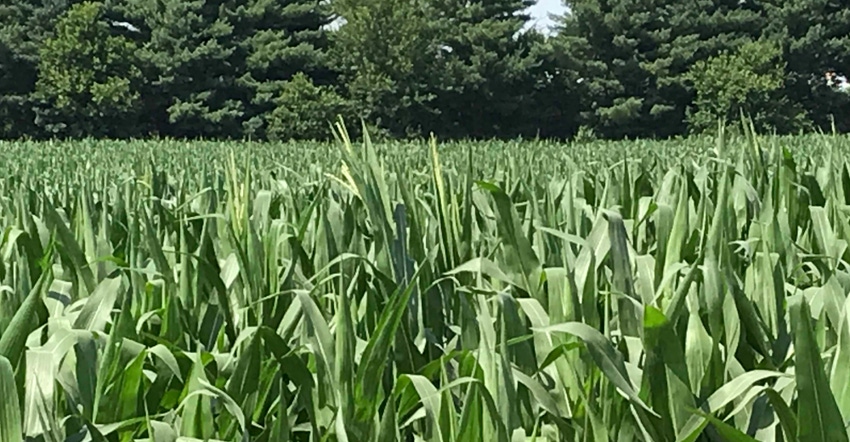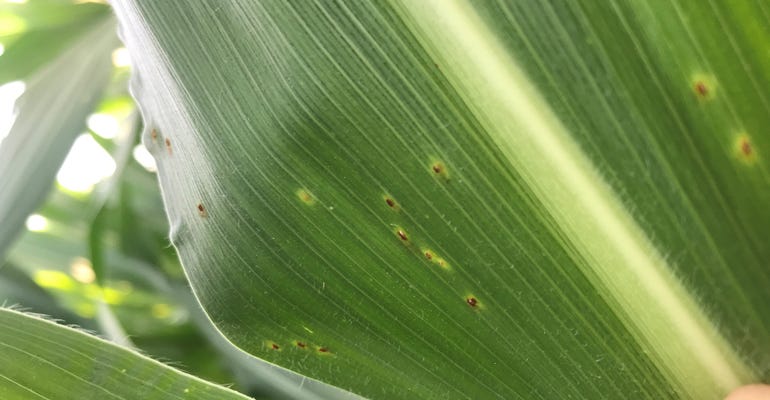July 12, 2019

A fairly new insect pest in Iowa — soybean gall midge larva — is showing up in some fields in western Iowa this July. Japanese beetles are also infesting some soybean fields, while foliar diseases are present in more of the cornfields each week.
Weed management issues are some of the more common problems ISU Extension field agronomists came across in fields this past week. And as for precipitation, some areas had plenty, while others had none at all. For rainfall totals across the state, see water.weather.gov/precip.
For more information about what’s happening in specific regions across the state, read the following reports. Here’s what ISU field agronomists in various locations around Iowa had to say about crop conditions as of July 9.
Northwest Iowa
Joel DeJong (Region 1). “In the northwest corner of Iowa we are seeing a wide range of corn growth. Early planted corn is around V13 growth stage and about 10 to 14 days from tasseling. Some of the June planted corn is about V6 to V7, and still somewhat showing striping of the leaves, a symptom of the inability to get roots into the fertilizer. I’m always amazed how rapidly corn grows when the system is well established, moisture is available and average temperatures for early July are present.”
Soybeans are beginning to flower in many fields although the latest planted ones are not that far along yet, says DeJong. Soybean gall midge larvae damage became more evident in many northwest Iowa counties this past week. “I’ve also been asked about stalk borers in soybean field edges this year several times,” he adds. “Postemergence soybean spraying continues. It will be interesting to see if the big weeds present in some fields can be controlled or only set back.”
Paul Kassel (Region 2). “Crop development continues to progress. A recent trip to Palo Alto County — an area that had good planting progress this spring — showed a lot of corn in the V12 stage and soybeans in V8 to R2 stage. We will likely start to see a few tassels in this early planted corn around the last week of July. That’s the good news; however, the rest of my area had a fair amount of corn planted in early June. This early June planted corn is developing at a good pace but is in the V7 to V8 stage currently.”

HAIL DAMAGE: Soybean plants are recovering from a June 27 hailstorm in Clay County in northwest Iowa.

Kassel adds, “Farmers in Clay County that had hail damage from the June 27 hail event had to evaluate their options. There was some replanting of the soybean crop, although that activity was delayed by rain during the Fourth of July weekend. Other farmers are considering small grains or millets for cover crops and/or forage crops, and are finding that seed supplies of these forage crops are in short supply."
Central Iowa
Meaghan Anderson (Region 7). “Much of central Iowa got some rain last week, but some areas missed virtually all the rain and could use a nice rain. Corn root systems seem fairly shallow and some are suffering from the conditions at planting time. With the rain last week, the western reaches of my area (Boone, Dallas, Madison counties) received wind that caused root lodging in corn and a very small amount of green snap. Most corn is very close to tassel, so farmers should be scouting for foliar disease and keep an eye on insect activity as reproductive stages near.”
Japanese beetles are out and will be highly attracted to silks in corn, but they aggregate along field edges, so scout thoroughly before treating, Anderson says.
Corn rootworm beetles should be out as well. “High numbers are a good sign there may be significant feeding on roots belowground,” she notes, “but the only way to know for sure is to dig the roots! Many soybean fields are now in reproductive stages [flowering], and many soybeans in narrow rows have filled in the open row space. Most recent contacts have been about corn as a cover in prevented plant fields, herbicide options for July applications in soybean, and cleaning up large weeds in fields.”
Southwest and West Central
Aaron Saeugling (Region 6). “Early-planted corn is in late vegetative stages and looks very good. There were some isolated spots in Adams and Union counties of heavy rain and wind damage from a July 3 storm. Soybeans are all over the board with early-planted beans beginning to flower (R1). Weed control is an issue in fields with large weeds especially where burndown applications were not applied prior to planting.”
Insects dominate the conversation in the coffee shops with painted lady butterflies (adult thistle caterpillars) everywhere.

LATE PLANTING: A later-planted soybean field in southwest Iowa looks better since it got some rain.

“We also have an outbreak of soybean gall midge larvae damaging soybeans in fields adjacent to last year’s soybean fields where damage from soybean gall midge larvae was observed,” he says. “Farmers need to be scouting fields in southwest Iowa, especially west of U.S. Highway 71 for soybean gall midge larvae. Japanese beetles are also being reported causing defoliation damage in bean fields. Alfalfa fields look good, and good yields have been reported.”
East Central, Southeast and South Central
Rebecca Vittetoe (Region 8). “Corn ranges from V13 to V14 down to V5 to V6. I’ve noticed a few of the earlier-planted fields with some tassels starting to poke out. I’ve also started to notice some gray leaf spot lesions and common rust appearing in cornfields. As we approach the reproductive stages in corn, it will be important to scout for foliar diseases. Over the past weekend, some of the later planted cornfields did show signs of moisture stress and could benefit from some rain.”
She says, “Soybeans range from R2 down to V2 to V3. Insect pests that can be found in soybean fields include Japanese beetles and first-generation bean leaf beetles. I’ve also started to notice bacterial blight in some bean fields. Many farmers are taking the second cutting of hay. Weed management, herbicide drift, foliar diseases in corn, and cover crop options for prevent plant fields were some of the common questions over the last week.”

LEAF DISEASE: Common rust, a foliar leaf disease, was found in a cornfield in Washington County in southeast Iowa.

Virgil Schmitt (Region 9). “Rainfall last week was from less than 0.5 inch (roughly south of Highway 92) to between 0.5 and 2 inches (roughly north of Highway 92) with some areas receiving between 2 and 3 inches in thunderstorms. Fieldwork days last week ranged from zero to seven, depending on location. April-planted corn is mostly V13 to V14; mid-May-planted corn is mostly V11 to V12; and June-planted corn is mostly V7.”
Post-herbicide applications are wrapping up, Schmitt says. “There was some corn leaf rolling due to moisture stress on some hot days last week, even in fields where soil moisture was abundant; there wasn’t a large enough root system to be able to move water into the plant fast enough.”
Soybeans range from R2 down to V2 growth stage, he notes. “Post-herbicides are being applied. There was quite a bit of hay harvesting activity last week where weather allowed. Japanese beetles are becoming very evident, and there is European corn borer shot holing in some corn. Inquiries about weed management, herbicide use, herbicide injury and cover crops continued to dominate calls last week.”
About the Author(s)
You May Also Like






